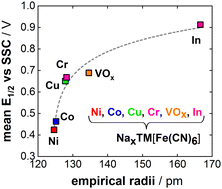High voltage and superior cyclability of indium hexacyanoferrate cathodes for aqueous Na-ion batteries enabled by superconcentrated NaClO4 electrolytes†
Abstract
Transition metal hexacyanometallates, so-called Prussian Blue Analogs (PBAs), have received massive attention as aqueous Na-ion battery electrode materials for large-scale energy storage systems not only due to their simple and low-cost synthesis procedures but also a superior cycling life. Still, aqueous Na-ion batteries based on PBA cathodes generally exhibit low energy density due to the relatively low redox potential and limitation of the electrochemical stability of aqueous electrolytes. It has been reported that the larger the empirical radii of the nitrogen-coordinated transition metal are, the higher the redox potential is obtained. In this context, sodium indium hexacyanoferrate appears to have a high potential to be a high-voltage cathode for aqueous Na-ion batteries. In this study, electrochemically deposited NaIn[Fe(CN)6] thin films demonstrated a promising performance as cathode materials for aqueous Na-ion batteries. Such electrodes showed a very high ‘mean half-charge potential’ of 1.57 V vs. RHE (at pH = 5.8, 1.0 V vs. SSC) and a specific capacity of 58 mA h g−1, making full use of the extended stability window of highly concentrated aqueous sodium perchlorate electrolyte (8 M). A strong dependence of the electrode stability on the employed electrolyte anion (ClO4− > NO3− > SO42−) and concentration was found, as well as on the anodic cut-off potential. These electrodes showed high stability with 75% capacity retention even after more than 16 000 cycles for a reduced potential window. Previously found correlations for the formal electrode potentials of PBA-based cathode materials can be confirmed for NaIn[Fe(CN)6] as well: the quasi-reversible potential for intercalation/deintercalation of alkali metal cations appears to increase as the hydration energy of alkali metal cations becomes less negative. The nature of the nitrogen-coordinated transition metal present in various hexacyanoferrate-based PBAs appears to be involved in determining the electrode potential: the bigger empirical radii of these transition metals seem to correlate with the more positive electrode potentials.

- This article is part of the themed collection: Sodium-ion batteries – Topic Highlight


 Please wait while we load your content...
Please wait while we load your content...